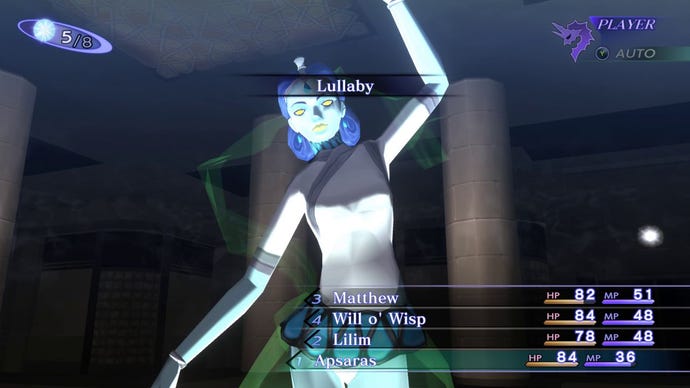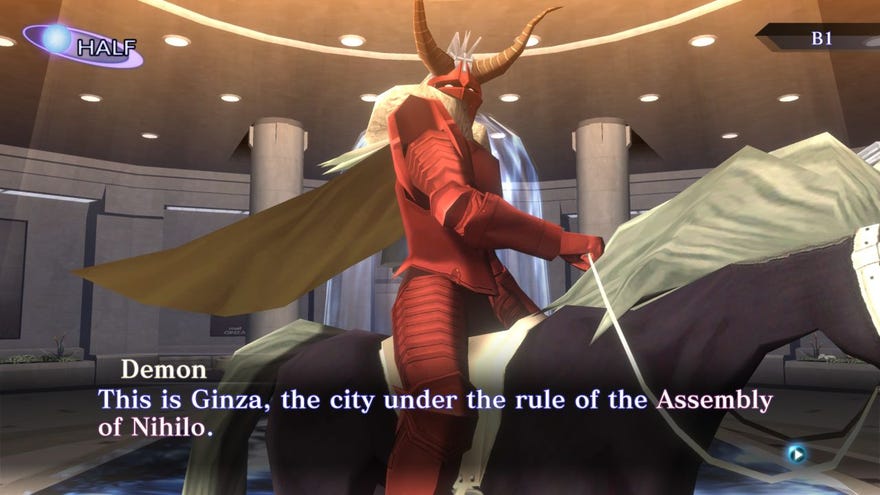Shin Megami Tensei 3: Nocturne HD Remaster review
Sympathy for the devils
My favourite description of the Shin Megami Tensei games is that they’re everything the religious right accused Pokémon of being in the late 90s. Back then parents fretted that Pikachu was secretly conscripting children into Satan’s army, what with the paranormal tinge of its bestiary and the presence of ‘undead’ Ghost types. When, as we all know, the only Pokémon you need to watch your kids around is Mr Mime. Powerful Operation Yewtree energy.
All the while Shin Megami Tensei was doing its thing in Japan, actively encouraging you to negotiate with a snake with the head of a dog in order to secure your rule in post-apocalyptic hellscapes. Pikachu was just a diversion! Well played, The Devil, well played.
It’s not just the demonic entities that give Shin Megami Tensei infernal energy; it’s the whole process of ensnaring them. Instead of wearing creatures down and snatching them at their most vulnerable, a la Pokémon press-ganging, you sweeten devils with bribes before opening a dialogue where you convince them that your motivations align. In Nocturne this Q&A portion appears to be randomised. The same answers can fail or work on any given monster. But what could feel frustrating actually imbues every negotiation with a spark of drama and plays nicely into the wild chaos that’s meant to have enveloped the world. Certainly more exciting than chucking a ball at them. I’d be way more down with the ‘mon if you earned the trust of Bulbasaur by convincing it you are a fellow nihilist.
 Shin Megami Tensei III Nocturne HD Remaster - Announcement Trailer | Nintendo Switch & PlayStation 4
Shin Megami Tensei III Nocturne HD Remaster - Announcement Trailer | Nintendo Switch & PlayStation 4
All this reminds me of Edge’s Doom review. "If only you could talk to these creatures, then perhaps you could try and make friends with them, form alliances." How we chuckled! Some of us even launched parody columns. But not in Japan. At the time of that review Shin Megami Tensei was already delivering that concept: a dungeon-crawling JRPG where humans bolster weedy powers by partnering with the very monsters out to deck them. Every whoosh of a random encounter could be a fight to the death or unexpected speed dating; a killer hook that has sustained roughly 357 sequels and spin-offs, of which 2003’s Nocturne was the first to head west. It now gets this HD Remaster, no doubt trying to leapfrog the popularity of Persona - one of the aforementioned 357 sequels and spin-offs.
In my head I’d always seen SMT games as the stern brother to Persona, stripping out the socialising portion to double down on dungeon-crawling. If you forgive my borked show chronology SMT is the Fraiser to Persona’s Cheers: enough familiar faces to make the connection, but with more of an intellectual bent and less after hours camaraderie.
"I’d be way more down with Pokémon if you earned the trust of Bulbasaur by convincing it you are a fellow nihilist."
That idea roughly holds up. After the bulging scope of Persona 5, Nocturne has a laser-like focus. A brief bit of scene setting introduces the five main characters, before one triggers the end of the world and turns Tokyo into a battle for the civilisation that will rise from the ashes. After this you’re rarely subjected to more than two minutes of cutscenes at a time, shifting the focus onto navigating the remains of famous Tokyo landmarks on the world map, descending into dungeons below and stopping for a random battle encounter every 20 steps. It’s a 3D JRPG from 2003, in other words, although the addition of an enemy proximity meter at least lets you steel yourself before the next drubbing.
It doesn’t make a great first impression. The early run of dungeons are featureless mazes, not helped by a sparse art style that makes them both hard to navigate without constant trips to the map screen, and quite boring to explore. Later labyrinths add wrinkles to spice up the endless corridors - rotating floor tiles, mirrored realities and pockets of darkness you ward off with flash bombs - but it still feels a bit bare. The remaster does it few favours in this regard: expanding the 4:3 view (aside from ropey FMV sequences ripped straight from PS2) and sharpening the models only emphasises the emptiness and repeated tile textures of this lonely geometry. And the decision to cap PC at 30 frames is truly baffling, instantly putting you in a PS2 headspace. Last year’s Persona 4 port was more technically flexible and released at half the price of this remaster, making Nocturne HD a harder sell.
The price and limitations of the port are awkward hurdles for a game I imagine was intended to serve as a friendly introduction to Shin Megami Tensei. Especially on PC where the series has not previously appeared, and where Atlus (and their Sega owners) are now focusing more of their efforts. And if you can ignore those tripping points, it is a fun place to start. Dropping the crustier first-person perspective favoured by the series, and using the same engine as Persona 3 and 4 offers an easier foothold in SMT’s weird world, letting you dig freely into its combat systems and pleasingly odd vibe.

I love the ghosts of Tokyo’s residents, for example, oblivious to their tragic fates and having a good old moan as the apocalypse unfolds around them. Or the juxtaposition of Ginza shopping malls and red demon knights on horseback, grumbling about their lot as JRPG fodder. All the monster designs do it for me. Some are Pokémon by way of Tim Burton, others look like failed first drafts of Japan’s regional mascots. There are things that look like haunted paper plates and sound like Clangers when they die. There are slimy goops who can appear in lines of six that resemble a melted boy band. At one point you get to fight an actual Thor.
If you’ve played Persona you’ll recognise this bestiary, but it’s so much more present here. What with the monsters taking three spots of your party it feels like you get to know them better. Not in a personality sense - your companions are absent in all story beats - but as loyal soldiers. In Persona, where you simply call upon demonic moves in battle, they are more abstracted. Here you get attached to the belly dancers and samurais you nurture to higher levels, even feeling a sting of guilt when you decide to fuse two into a stronger monster in the Cathedral of Shadows. This is vital for creating high level and rare monsters, and plugging their vulnerabilities by inheriting moves they otherwise wouldn’t have from both sets of parents. The near infinite variety of outcomes is what sustains a higher difficulty replay, where optimising the party takes on more significance.
All this is nothing without combat to harness the monsters, and here Nocturne is a JRPG with a real zip and rhythm of its own. Turn-based combat hinges on actions that can be stretched out by hitting a foe’s elemental weakness or landing critical hits, each earning a bonus turn up to four moves. Get in the groove with this - matching your party’s elemental magics to the common enemy types in a given area - and you can wallop ambush after ambush. Better still: if you dodge incoming attacks or null their magics with your own immunities you sap actions from the enemies’ turn, defanging them in an instant and welcoming you quickly back to the walloping zone. Another cool side effect is that it makes this the rare JRPG where normally unsexy support buffs can really shine, as a pumped-up squad dances past blows and eats enemy turns in the process. In full swing it’s beautifully reactive stuff.

Of course, the flipside is that all this goes for the enemy, too. It’s very possible for even a pitiful slime pile to get the drop on you and ride those extra turns to your extinction. As a result, Nocturne has a reputation for being difficult, but that stems more from poor in-game tutorials and stat screens that could explain themselves better. Handily, the time since 2003 has allowed for ample wikis to fill in the gaps, but that could have been folded into the remaster to considerable effect. Instead its one nod to newcomers is a new ‘merciful’ difficulty mode that is such a pushover it guts everything interesting about the combat.
Also: a huge slap on the wrist for whoever decided to siphon SMT3’s bonus modes into paid DLC as part of a Digital Deluxe Edition. Selling Maniax mode is particularly off - this mode adds extra story beats revolving around a super hard dungeon you unlock by targeting special enemies (and weirdly lets Devil May Cry’s Dante join your party). What’s wild is that this Maniax ‘director’s cut’ was the original western version of SMT3, so the vanilla remaster being sold is technically a lesser take of what you could have owned in 2003. Atrocious treatment of returning fans.
And that’s indicative of the whole: a remaster that takes a characterful, if clearly old game, and doesn’t quite give it the love needed to hold its head high in 2021. After Sega’s amazing PC run - launching Yakuza 0 and Persona 4 at £15 earned a big thumbs up - this feels like wanton gouging, and for a game that is more interesting than essential. Maybe the devil made them do it. Either way, it's a shame.


